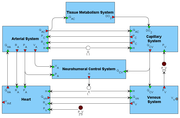Difference between revisions of "Short term model of the heart output regulation"
From BioUML platform
Tagir Valeev (Talk | contribs) |
Tagir Valeev (Talk | contribs) m (Link to modular model) |
||
| Line 4: | Line 4: | ||
The ventricle is modeled as a pump switching between two regimes: systole and diastole. The model also operates with the oxygen debt concept and includes neuro-humoral regulation. | The ventricle is modeled as a pump switching between two regimes: systole and diastole. The model also operates with the oxygen debt concept and includes neuro-humoral regulation. | ||
| − | It was recreated | + | It was recreated as a [[Modular modeling|BioUML modular model]]. The recreated model contains: |
*58 parameters, | *58 parameters, | ||
Latest revision as of 12:17, 7 May 2013
The model was developed by Y.V. Solodyannikov [1] and describes systemic blood flow through the certain reservoirs of the human body: the left ventricle, the arterial system and the venous system. The model has high time resolution with regime duration ~0.5 s. The ventricle is modeled as a pump switching between two regimes: systole and diastole. The model also operates with the oxygen debt concept and includes neuro-humoral regulation.
It was recreated as a BioUML modular model. The recreated model contains:
- 58 parameters,
- 14 assignments,
- 6 ordinary differential equations,
- 2 descrete events corresponding to systole-diastole and diastole-systole transitions.
[edit] References
- ↑ Solodyannikov Y.V. The elements or mathematical modeling and hemodynamics system identification. Samara: The university of Samara, 1994.
